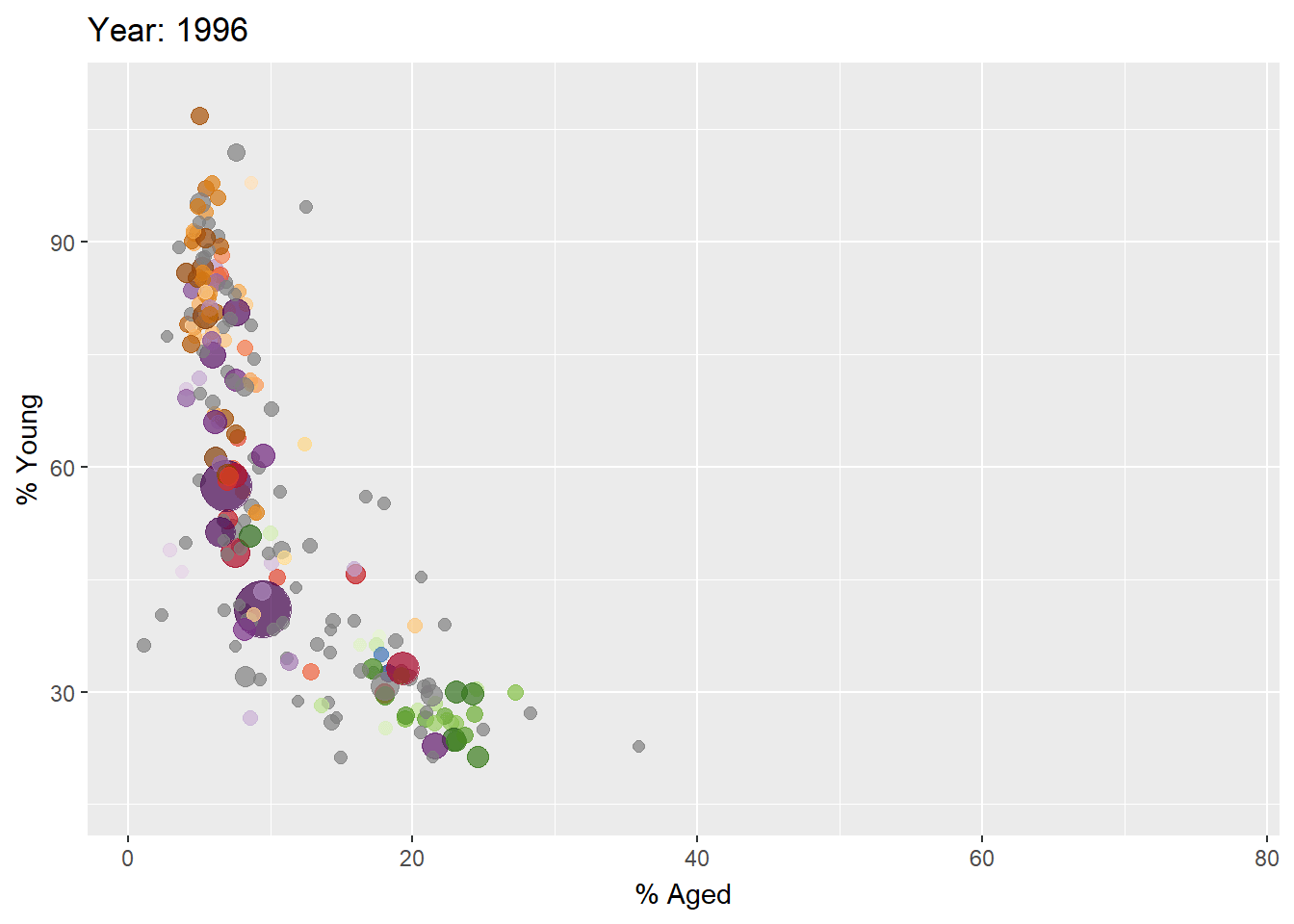pacman::p_load(readxl, gifski, gapminder,
plotly, gganimate, tidyverse)Hands-on Exercise 3b:Programming Animated Statistical Graphics with R
1 Getting Started
In this exercise, we will use the following our R packages.
ggiraph: for making ‘ggplot’ graphics interactive.
gganimate, an ggplot extension for creating animated statistical graphs.
gifski converts video frames to GIF animations using pngquant’s fancy features for efficient cross-frame palettes and temporal dithering. It produces animated GIFs that use thousands of colors per frame.
tidyverse, a family of modern R packages specially designed to support data science, analysis and communication task including creating static statistical graphs.
gapminder An excerpt of the data available at Gapminder.org. We just want to use its country_colors scheme.
The code chunk below uses p_load() of pacman package to check if these packages are installed in the computer and load them onto your working R environment.
The code chunk below imports Data worksheet from GlobalPopulation Excel workbook by using appropriate R package from tidyverse family.
col <- c("Country", "Continent")
globalPop <- read_xls("data/GlobalPopulation.xls",
sheet="Data") %>%
mutate_each_(funs(factor(.)), col) %>%
mutate(Year = as.integer(Year))read_xls() of readxl package is used to import the Excel worksheet.
mutate_each_()of dplyr package is used to convert all character data type into factor.mutateof dplyr package is used to convert data values of Year field into integer.
Unfortunately, mutate_each_() was deprecated in dplyr 0.7.0. and funs() was deprecated in dplyr 0.8.0. In view of this, we will re-write the code by using mutate_at() as shown in the code chunk below.
col <- c("Country", "Continent")
globalPop <- read_xls("data/GlobalPopulation.xls",
sheet="Data") %>%
mutate_at(col, as.factor) %>%
mutate(Year = as.integer(Year))Instead of using mutate_at(), across() can be used to get the same outputs.
col <- c("Country", "Continent")
globalPop <- read_xls("data/GlobalPopulation.xls",
sheet="Data") %>%
mutate(across(col, as.factor)) %>%
mutate(Year = as.integer(Year))The code chunk below uses summary()to summarize the data.
summary(globalPop) Country Year Young Old
Afghanistan: 28 Min. :1996 Min. : 15.50 Min. : 1.00
Albania : 28 1st Qu.:2010 1st Qu.: 25.70 1st Qu.: 6.90
Algeria : 28 Median :2024 Median : 34.30 Median :12.80
Andorra : 28 Mean :2023 Mean : 41.66 Mean :17.93
Angola : 28 3rd Qu.:2038 3rd Qu.: 53.60 3rd Qu.:25.90
Anguilla : 28 Max. :2050 Max. :109.20 Max. :77.10
(Other) :6036
Population Continent
Min. : 3.3 Africa :1568
1st Qu.: 605.9 Asia :1454
Median : 5771.6 Europe :1344
Mean : 34860.9 North America: 976
3rd Qu.: 22711.0 Oceania : 526
Max. :1807878.6 South America: 336
2 Animated Data Visualisation: gganimate methods
gganimate extends the grammar of graphics as implemented by ggplot2 to include the description of animation. It does this by providing a range of new grammar classes that can be added to the plot object in order to customise how it should change with time.
transition_*()defines how the data should be spread out and how it relates to itself across time.view_*()defines how the positional scales should change along the animation.shadow_*()defines how data from other points in time should be presented in the given point in time.enter_*()/exit_*()defines how new data should appear and how old data should disappear during the course of the animation.ease_aes()defines how different aesthetics should be eased during transition
2.1 Building a static population bubble plot
The basic ggplot2 functions are used to create a static bubble plot.
ggplot(globalPop, aes(x = Old, y = Young,
size = Population,
colour = Country)) +
geom_point(alpha = 0.7,
show.legend = FALSE) +
scale_colour_manual(values = country_colors) +
scale_size(range = c(2, 12)) +
labs(title = 'Year: {frame_time}',
x = '% Aged',
y = '% Young')
2.2 Building the animated bubble plot
In the code chunk below,
- transition_time() of gganimate is used to create transition through distinct states in time (i.e. Year).
ease_aes()is used to control easing of aesthetics. The default is linear. Other methods are: quadratic, cubic, quartic, quintic, sine, circular, exponential, elastic, back, and bounce.
Code
ggplot(globalPop, aes(x = Old, y = Young,
size = Population,
colour = Country)) +
geom_point(alpha = 0.7,
show.legend = FALSE) +
scale_colour_manual(values = country_colors) +
scale_size(range = c(2, 12)) +
labs(title = 'Year: {frame_time}',
x = '% Aged',
y = '% Young') +
transition_time(Year) +
ease_aes('linear') 
3 Animated Data Visualisation: plotly
Both ggplotly() and plot_ly() in Plotly R packages support key frame animations through the frame argument/aesthetic. They also support an ids argument/aesthetic to ensure smooth transitions between objects with the same id.
3.1 Building an animated bubble plot: ggplotly() method
The animated bubble plot above includes a play/pause button and a slider component for controlling the animation
gg <- ggplot(globalPop,
aes(x = Old,
y = Young,
size = Population,
colour = Country)) +
geom_point(aes(size = Population,
frame = Year),
alpha = 0.7,
show.legend = FALSE) +
scale_colour_manual(values = country_colors) +
scale_size(range = c(2, 12)) +
labs(x = '% Aged',
y = '% Young')
ggplotly(gg)Appropriate ggplot2 functions are used to create a static bubble plot. The output is then saved as an R object called gg
ggplotly()is then used to convert the R graphic object into an animated svg object.
Notice that although show.legend = FALSE argument was used, the legend still appears on the plot. To overcome this problem, theme(legend.position=‘none’) should be used as shown in the plot and code chunk below
gg <- ggplot(globalPop,
aes(x = Old,
y = Young,
size = Population,
colour = Country)) +
geom_point(aes(size = Population,
frame = Year),
alpha = 0.7) +
scale_colour_manual(values = country_colors) +
scale_size(range = c(2, 12)) +
labs(x = '% Aged',
y = '% Young') +
theme(legend.position='none')
ggplotly(gg)3.2 Building an animated bubble plot: plot_ly() method
bp <- globalPop %>%
plot_ly(x = ~Old,
y = ~Young,
size = ~Population,
color = ~Continent,
sizes = c(2, 100),
frame = ~Year,
text = ~Country,
hoverinfo = "text",
type = 'scatter',
mode = 'markers'
) %>%
layout(showlegend = FALSE)
bp